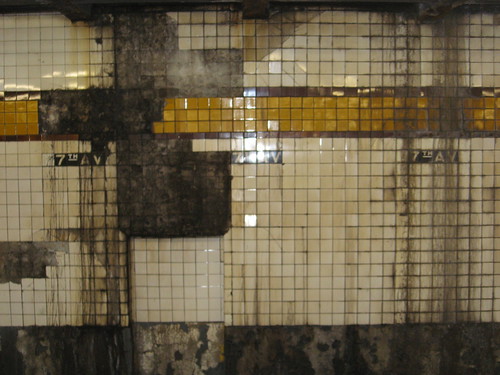The 7th Ave. station along the Culver line in Brooklyn has seen better days. (Photo by Benjamin Kabak)
A state of good repair. The MTA tosses that phrase around a lot these days, but no one really knows what it means.
New Jersey Transit defines it as follows: “‘State of Good Repair” is achieved when the infrastructure components are replaced on a schedule consistent with their life expectancy.” The MTA’s definition is, for all intents and purposes, the same.
In New York over the last twenty five years, the MTA has been fighting an uphill battle to return the subway system to a state of good repair. They’ve overhauled track beds and switches; they’ve purchased new rolling stock. And when time and money allows, they’ve attempted to redo stations, but it is here that we run into differing opinions over what exactly a state of good repair entails.
Over the weekend, Times reporter Javier C. Hernandez ventured out into some of the 19 stations that will see their renovation plans deferred. As expected, commuters who frequent those stations aren’t too pleased to hear that the MTA is forgoing outer-borough renovations yet again:
In the distance is one of the city’s most stunning views: the Statue of Liberty, Manhattan skyscrapers and a pristine New York Harbor. But the trip to the top of Brooklyn’s Smith-Ninth Street subway station, the highest in the city, is not so appealing.
Inside the station, scraps of paint fall from the ceiling as commuters make their way up cracked, rusty steps. “I’ve been waiting so long for things to change,” said Steven De Jesus, a contractor who commutes by train. He pointed to the peeling walls. “It’s horrifying and despicable right now.”
[snip]
The authority has said that the stations, which sit above ground on the D, N, F and G lines in Brooklyn and the No. 6 line in the Bronx, were in good condition and posed no safety risks. But commuters say the stations urgently need attention. At some stations, stairways are crumbling, water is leaking through the ceilings and outdoor roofs, and gaps between wooden planks are widening.
Therein lies the rub. The stations may post no safety risks, but anyone who subscribes to the City Beautiful notion of public works won’t be too pleased.
Above this post is one of a set of five photos I snapped a few weeks ago in the 7th Ave. station on the Culver line; one, two, three and four are all available on flickr. The truth is that this station — and many like it — is not in a state of physical repair. Dirty water has corroded station tiles, and streaks of something run down the walls. In some spots, the tiles are gone; in others, they’re buckling. It’s generally not very nice.
But when funds are tight, the station renovation plans get the axe, but these superficial appearances don’t matter nearly as much as modern signals and solid track beds. In the end, the MTA will face more complaints from people dismayed with the state of their surroundings, and as the stations grow grimier, they take on the appearance of something less than desirable in any neighborhood. But until money flows the MTA’s way, that physical part of the state of good repair will be the first thing to go when the budget crunches arrive.


3 comments
Considering that some stations had their last facelift 20-30 years ago, I wonder how much lead is in that peeling paint.
[…] but the latest facts about the MTA. As budgets sag, construction projects get held up and that elusive state of good repair slips […]
[…] talk eventually turned to the state of the system. We all know about the MTA’s attempts to restore the system to a state of good repair, and we all know that the trains are very crowded with many lines running at or near capacity. […]